NOTE: Bloomberg Second Measure launched a new and exclusive transaction dataset in July 2022. Our data continues to be broadly representative of U.S. consumers. As a result of this panel change, however, we recommend using only the latest posts in assessing metrics, and do not support referring to historical blog posts to infer period-over-period comparisons.
New Year’s resolutions hold the promise that maybe this year will be different. Yet, the typical goals stay the same—quintessentially: get fit. Each year, when the January crowd emerges to worship at the temple of iron, fitness centers tend to see an increase in new customers. Given how bad most of us are at sticking to our New Year’s resolutions, it may come as a surprise that these January joiners don’t throw in the towel any earlier than most. At some gyms, they even tend to keep their memberships longer.
All fitness centers can expect more members to join in January than in the average month. And for many gyms, this month could shape up to be their biggest of the year. One of the least-expensive options, Planet Fitness, had the bulkiest New Year’s spike last year—79 percent more new customers signed up in January than in the average month.
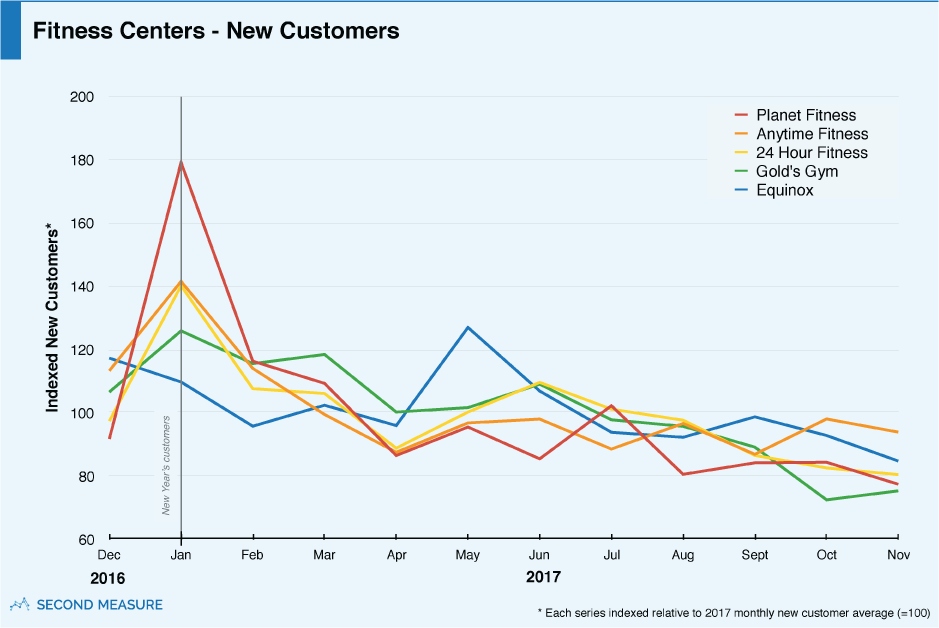
At Planet Fitness, January sign-ups keep their memberships longest
Despite the stigma against the New Year’s gym crowd, January new members were just as likely as customers who joined throughout the rest of the year to keep their memberships—if not more so. Ten-month retention for new customers was especially striking at Planet Fitness, where the latest data shows that 66 percent of the January 2017 cohort is still active—or at least their autopay accounts are. Average 10-month retention for the preceding 11 cohorts was only 59 percent.
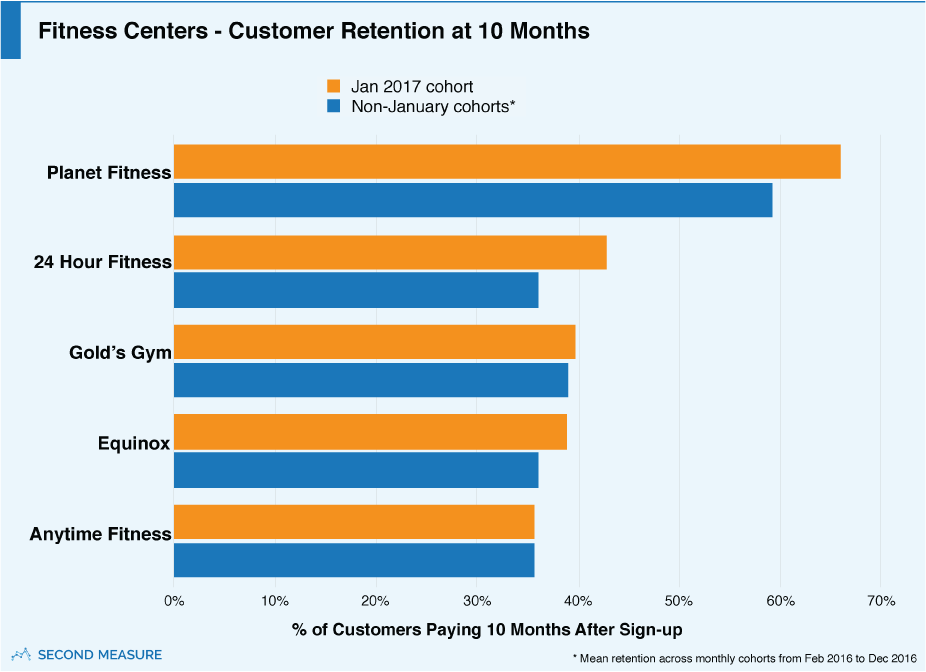
Planet Fitness offers a monthly fee of only $10 and advertises a “judgement-free” environment, which sets an attractively low barrier to entry for gym newcomers. Leaving is another matter—according to its website, you have to show up in person or send a letter to cancel a membership. Some no-show members may be willing to part with $10 to avoid that hassle and hang on to the promise that maybe next month things will be different.
At the other extreme, new Equinox customers can expect a monthly fee in excess of $150. And while membership grants access to equipment and classes, services like childcare and spa treatments run the bill even higher. These add-ons, coupled with an initial enrollment fee, lead Equinox customers to spend an average of $323 in their first month—and spending balloons from there. Equinox customers spend, on average, $1,520 in the first year of membership—more than triple what customers spend at other gyms.
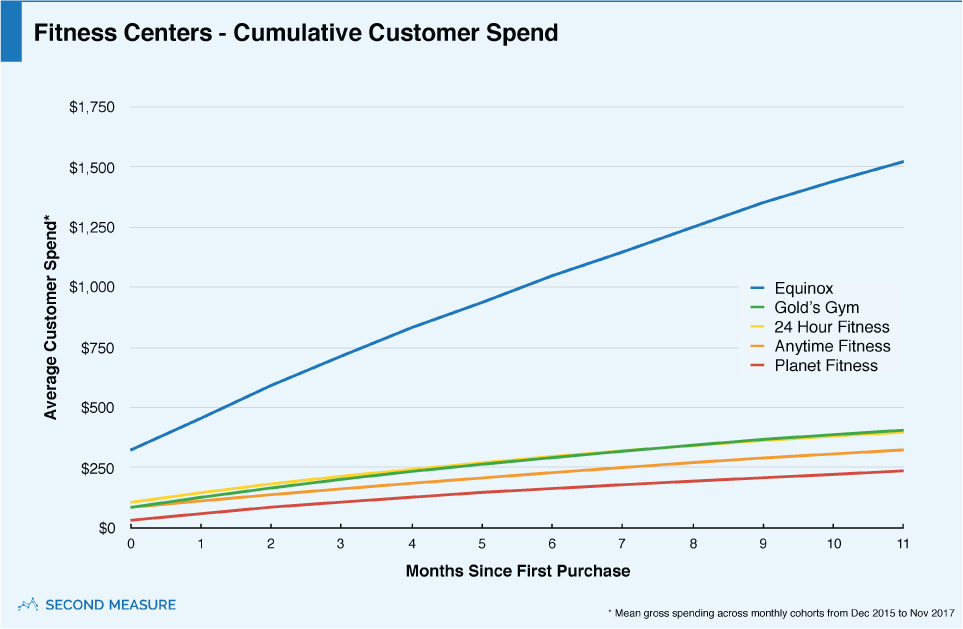
At boutique studios, new customers aren’t spending as much as you might think
For those getting fit in 2018, trendy boutique studios offer options beyond a traditional gym. They too see a swell of new customers—as much as 53 percent more than average at Pure Barre last January.
With a single class ranging from $20 to more than $30, boutique fitness can make Equinox look like a bargain. Yet, after one year, cumulative customer spending at studios is actually lower than at most fitness centers. At SoulCycle, Pure Barre, and YogaWorks, new customers spend less than $300 in their first year, on average. Bargain-brand Planet Fitness is the only traditional gym that can say the same.
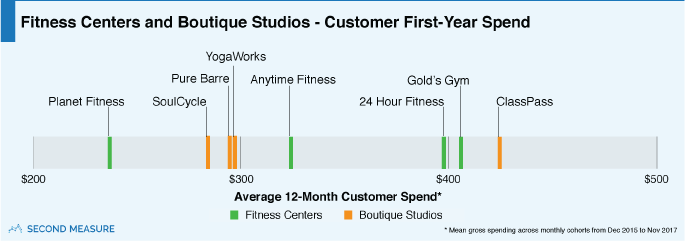
New customers typically spend less at boutiques in part because traditional gyms make it easier to fall into routine spending. Studios allow for a single-class purchase, while larger fitness centers are less likely to permit drop-ins. And gym members are billed cyclically, while studio customers can choose to pay for classes less often—or with untracked cash. Furthermore, monthly dues allow a traditional gym to potentially collect money from members who have stopped showing up, but class-based payments limit a studio’s ability to do the same.
For customers who do love their boutique workouts, studios often offer discounts when buying multi-class packages to use over several months. Since this payment model results in less predictable transaction patterns, comparing boutique brands using quarterly (instead of monthly) retention casts a wider net to better capture their customers’ spending. Even so, at the end of their first year, more than 80 percent of boutique customers don’t spend in the last quarter—with one exception.
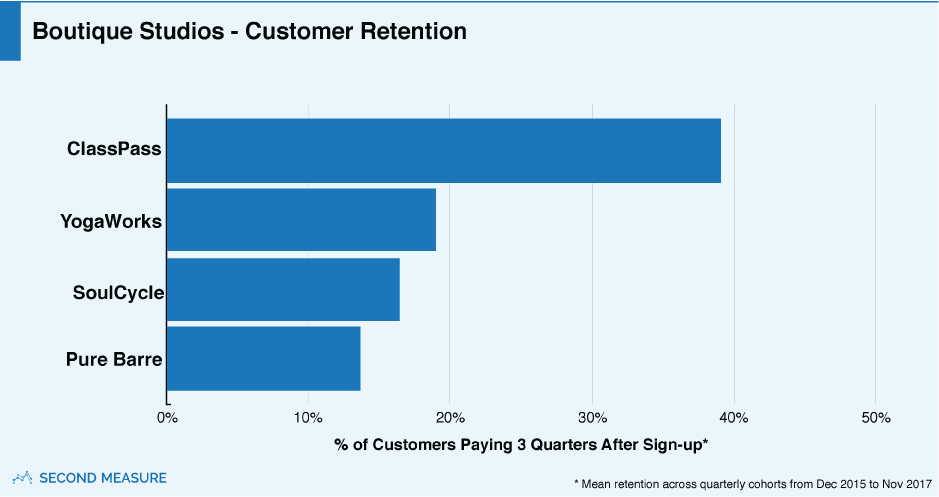
ClassPass, a web-based fitness company, attempts to solve the retention pitfalls of studio fitness—and appears to be succeeding. It’s a membership program (not an actual studio) that grants access to a selection of smaller boutique centers. Even though ClassPass caters to the studio crowd, its subscription model and broader workout selection are strikingly similar to a traditional gym. And like traditional gyms, ClassPass keeps customers coming back better than any single boutique. Quarterly retention at ClassPass averaged 39 percent at the end of year, whereas retention at the other boutique-brands averaged just 16 percent.
Our data team starts tracking new companies every day! To see how LA Fitness stacks up against these gyms, request a demo.
Oh, and we’re hiring.
